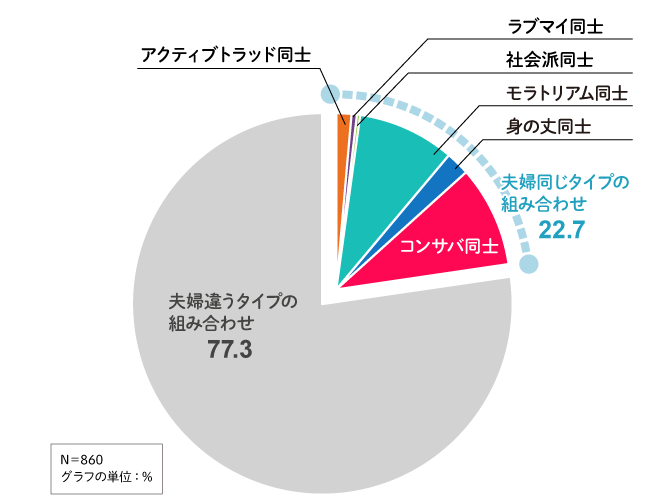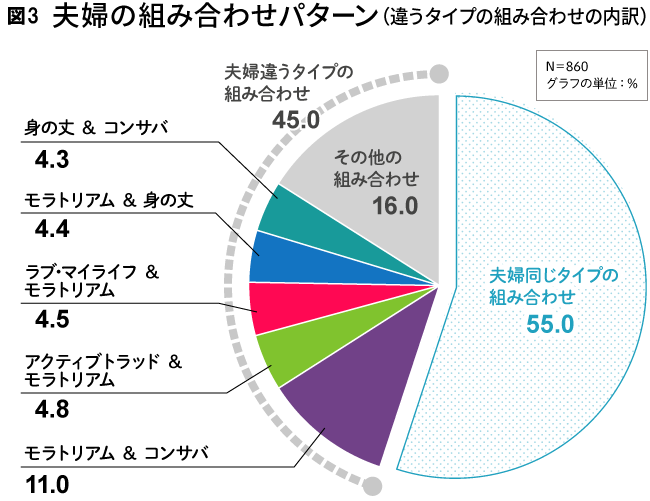As we advance our research on modern seniors, we frequently encounter situations where we realize that "seniors cannot be lumped together; they can be categorized into types based on differences in values." In such cases, we are often asked about the combinations of couples based on these types. Therefore, we conducted a survey of senior couples on this question and verified the results using the "Senior Value Segmentation" developed by our company's senior research team, the "VR Aging Lab."
The Senior Values Segmentation is a new approach to understanding the increasingly diverse and complex thinking and behaviors of the senior demographic, categorizing them based on their "values."
Values are categorized into six types. The diagram below plots each segment on a two-axis, four-quadrant grid: one axis measures whether behavior is proactive or reserved, and the other measures whether orientation leans toward traditional/conservative tendencies or a preference for change and stimulation.
Active Trad: Primarily consists of retirees living comfortably with ample time and money. They are proactive in consumption and activities but hold strong traditional family values. This segment most closely matches the image traditionally associated with "active seniors."
Love My Life: Strong pursuit of youth and beauty, anti-aging awareness, fond of new things, well-informed, and sensitive to trends. One of the "new types" of active seniors.
Socially-Minded Independents: Value human connections, are eager to build new networks and engage in cross-generational exchanges. Another pattern of the "new type of active seniors".
Unassuming Conservative: Fully satisfied with their current life, desiring nothing more. They hold no strong opinions and live each day calmly and peacefully. Closest to the traditional image of "elderly people."
Down-to-Earth Realist: Often expresses resignation, saying they don't have money or that something is too expensive to do. They aren't necessarily poor, but their consumption is passive, perhaps due to future anxieties.
Second Life Moratorium: They feel strongly about not wanting to be left behind by society and desire connections with people and society. However, they don't know how to achieve this and are searching for how to spend the rest of their lives.
【Reference】Senior Values Segmentation Details here↓
https://www.videor.co.jp/digestplus/title/2018/01/7717.html
[Determine Your Senior Values Segment]
Take the Senior Values Segment Assessment Here↓
https://www.videor.co.jp/digestplus/title/2018/01/7722.html
Couples tend to be "birds of a feather"!
Since there are 6 senior value segments, there are 36 possible "husband × wife" combination patterns. Examining these patterns reveals that 55% of couples share the same segment. This means over half of senior couples are similar types (Figure 1).
Looking at the details, the most common pairing is "Unfazed Conservatives" with each other. Next are "Second Life Moratorium" with each other, followed by "Down-to-Earth Realists" and "Active Traditions" with each other.
Interestingly, based purely on the segment composition ratios of each spouse, the theoretical probability of same-type pairings occurring should be just over 20% (Figure 2).
Yet, the fact that over 50% of combinations actually occur suggests that "couples tend to pair with similar types."
Two possible reasons for this are:
① People with similar values tend to marry each other.
② Even if they started with different values, over many years together, they influenced each other and became similar.
Regarding ①, it's plausible that the current senior generation experienced a "historical turning point in the process of marriage" (cited from the National Institute of Population and Social Security Research) where the rate of love marriages surpassed that of arranged marriages. This turning point occurred in the late 1960s, coinciding with when today's early 70-somethings reached marriageable age.
While this remains a hypothesis since our survey did not include those in their late 70s and above, for the generation where arranged marriages were still prevalent, matching based on conditions other than personal preference was the norm. Consequently, having shared values with one's spouse from the outset of marriage was likely a rare coincidence.
In contrast, today's seniors belong to a generation that gained the ability to choose their own marriage partners. It is conceivable that they existed in an environment more conducive to the formation of couples sharing similar values from the outset, compared to the generation preceding them.
Regarding point ②, in this survey, we found responses like, "We've been together for so long that I accept everything" (from a wife aged 64 in a Second Life Moratorium couple).
In fact, when interviewing seniors, it wasn't uncommon to hear them say things like, "Well, we're a couple of birds of a feather," even while making light-hearted or even critical remarks about their spouse. Some even remarked (perhaps self-consciously?) that "lately, we've even started looking alike."
The existence of proverbs like "birds of a feather flock together" or "marital couples resemble cousins" seems, in a way, to corroborate this sentiment.
Among different-type combinations, "Dull & Conservative & Second-Life Moratorium" is common
Next, let's look at combinations where the spouses have different value types.
The most common combinations were "Husband: Calm Conservative / Wife: Second Life Moratorium" (6.3%) and "Husband: Second Life Moratorium / Wife: Calm Conservative" (4.7%). Couples where one partner is either "Calm Conservative" or "Second Life Moratorium" made up over 10% of the total, the most frequent combination.
Next were combinations where either spouse was "Active Traditionalist & Second Life Moratorium," at about 5%. Following these were "Love My Life & Second Life Moratorium," "Second Life Moratorium & Down-to-Earth Realist," and "Down-to-Earth Realist & Unassuming Conservative," each at around 4%. All other combinations were below 3%. (Figure 3)
Incidentally, the least common combination was "Love My Life & Calm Conservative" (0.9%). Whether it's the husband or wife, the most aggressive type and the most peace-loving type may find it difficult to coexist.
Contact: hitoken@videor.co.jp
●Survey Overview
Participants: 860 married couples aged 55–74
Survey Method: Online survey
Survey Period: November 2016
Solution Business Division, Human Research Institute, Aging Lab Leader: Tomiko Tsushima
Video Research Ltd. "Human Research Institute VR Aging Lab"
A senior research project launched to revitalize the senior market. We conduct research activities, disseminate information, and provide consulting services to companies for senior marketing, aiming to capture the reality of seniors and apply it to marketing activities.
Human Research Institute: http://www.videor.co.jp/hitoken/#anc2







